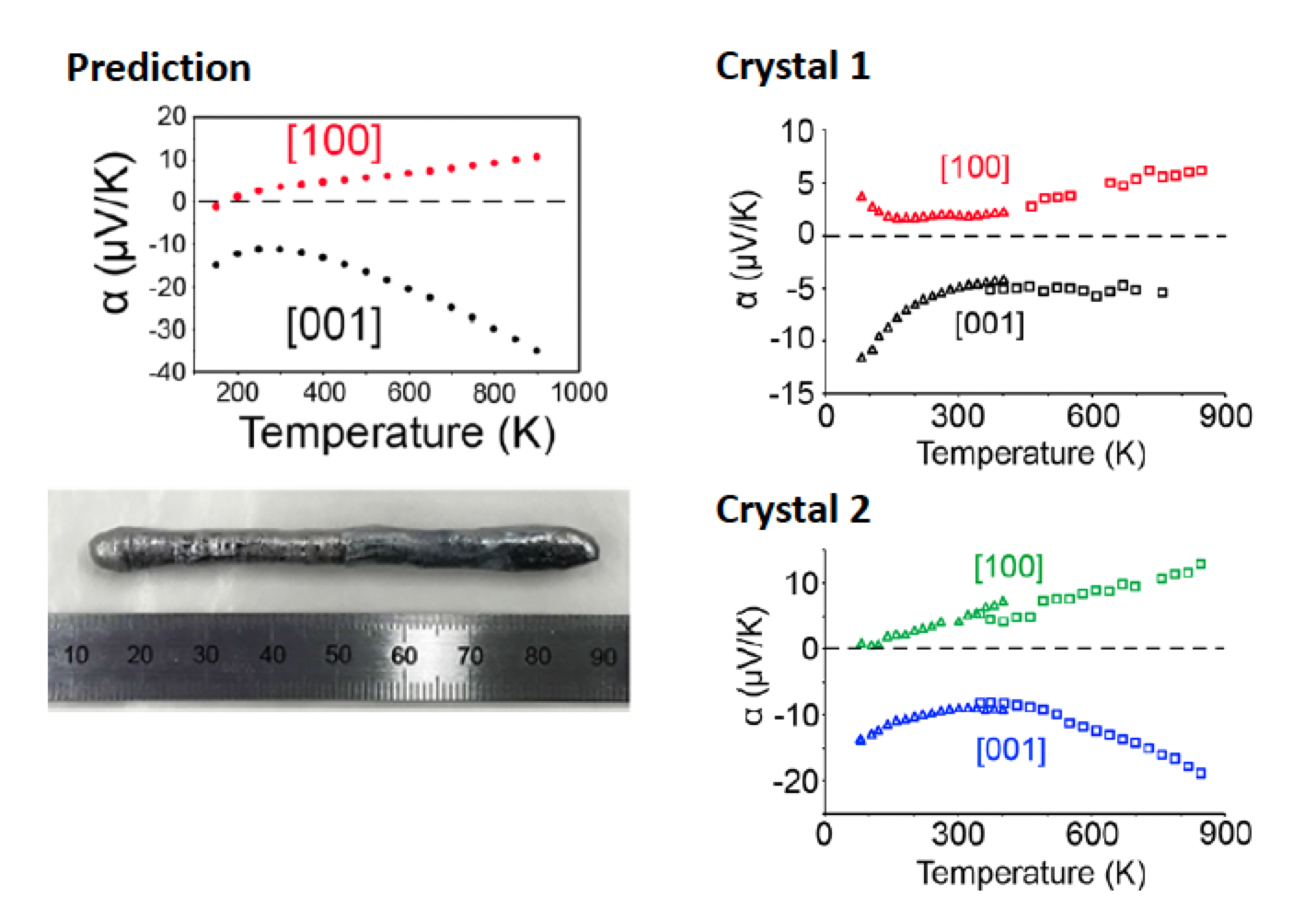PARADIM Highlight #78—External User Project (2023)
Josh E. Goldberger, J.P. Heremans, and W. Windl (Ohio State University)
Materials that demonstrate axis-dependent conduction polarity enable new technologies by integrating p- and ntype functionality into a single crystal. One example is the transverse thermoelectric, in which difficult to fabricate alternating pillars of n- and p-type doping are replaced with a single material.

Figure 1: (top) Calculated thermopowers at E − Ef = 0 as a function of temperature. (right) Thermopowers of single crystals 1 and 2 of WSi2 as a function of temperature, measured along both the [001] (black, blue) and [100] (red, green) directions.
Users from The Ohio State University theoretically predicted axis-dependent conduction polarity in tetragonal α-WSi2—a durable, thermally robust, and oxidation-resistant metal synthesized from earth-abundant elements. Two single crystals of α-WSi2 were prepared at PARADIM’s Bulk Crystal Growth Facility using floating zone techniques, and their anisotropic conduction properties were evaluated. Simultaneous positive and negative thermopowers measured along the [100] and [001] directions, respectively, indicate that this material exhibits axisdependent conduction polarity, which closely matches theoretical predictions.
Materials that demonstrate axis-dependent conduction polarity enable new technologies by integrating p- and n-type functionality into a single crystal. Certain anisotropic crystal structures give rise to this behavior by having dominant electron conduction along one crystallographic direction and dominant hole conduction along another. However, only a few materials have been experimentally shown to demonstrate this unique property. Users from The Ohio State University theoretically predicted axis-dependent conduction polarity in tetragonal α-WSi2: a durable, thermally robust, and oxidation-resistant metal synthesized from earth-abundant elements. Two single crystals of α-WSi2 were prepared at PARADIM’s Bulk Crystal Growth Facility using floating zone techniques, and their anisotropic conduction properties were evaluated. Simultaneous positive and negative thermopowers measured along the [100] and [001] directions, respectively, indicate that this material exhibits axis-dependent conduction polarity, which closely matches theoretical predictions. Hall measurements also show dominant p-type and n-type conduction along these respective crystallographic directions. Heat capacity measurements indicate that the density of states of these crystals is close to that of an exact α-WSi2 stoichiometry, confirming that this polarity anisotropy exists in relatively undoped crystals.
The transverse thermoelectric, in which difficult to fabricate alternating pillars of n- and p-type doping are replaced with a single material, has the potential to dramatically reduce costs associated with these clean energy sources that also have space-based applications. These results demonstrate that α-WSi2, an easier to prepare and more stable compound than any discovered previously, is an excellent material platform for the future exploration of potential applications of this phenomenon.
PARADIM’s Bulk Crystal Growth Facility at Johns Hopkins University is a unique place in the United States offering the entire suite of optical floating zone techniques.
The work was initiated by researchers from The Ohio State University based on their theoretical calculations and to realize the material at PARADIM’s Bulk Crystal Facility.
K.G. Koster, Z. Deng, C.E. Moore, J.P. Heremans, W. Windl, and J.E. Goldberger, "Axis-Dependent Conduction Polarity in WSi2 Single Crystals," Chem. Mater. 35, 4228-4234 (2023)
The material used in this work was supported by the NSF-MIP Platform for the Accelerated Realization, Analysis, and Discovery of Interface Materials (PARADIM) under Cooperative Agreement No. DMR-2039380. The authors would like to acknowledge Lucas Pressley and Mojammel Khan at the NSF PARADIM facility for helping to grow large single crystals of WSi2. J.E.G. and W.W. also acknowledge the Air Force Office of Scientific Research for funding from grant number FA9550-21-1-02684 and J.P.H. acknowledges the Department of Energy for funding under grant number DE-SC0020923, “Discovery of goniopolar metals with zero-field Hall and Nernst effects.” Calculations were performed at the Ohio Supercomputer Center under grant number PAS0072.







